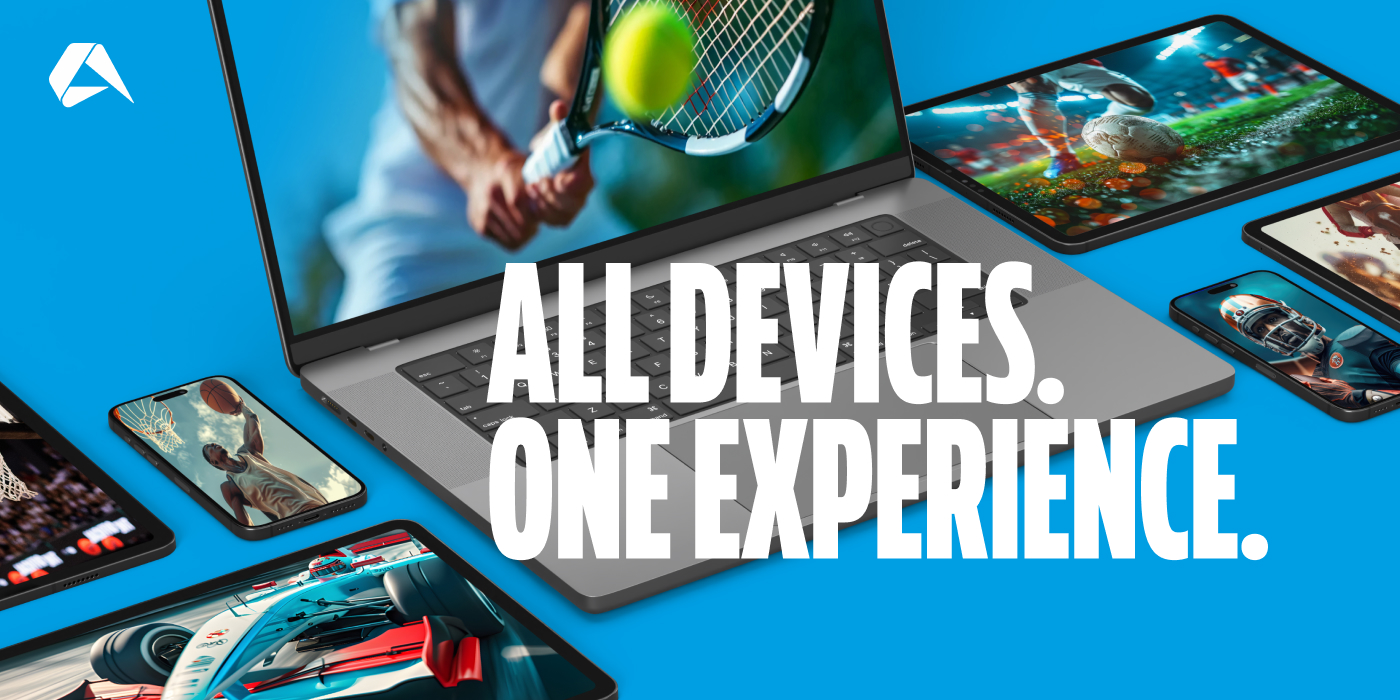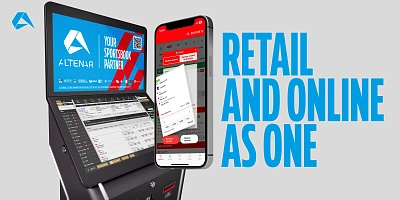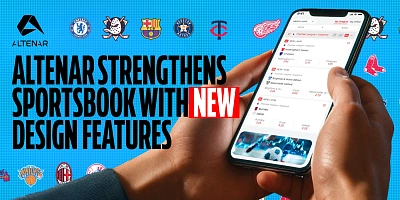The evolution of sports betting has not always followed a straight line. From bookmakers and betting shops to websites and mobile apps, each step forward has reshaped how players interact and how products are built. But something’s changed recently. Bettors today aren’t just mobile-first - they’re everywhere-first.
The modern bettor moves between devices in minutes, not hours, and they expect the experience to keep up. Speed, consistency, and continuity across screens are the new baseline. And for operators, that raises the stakes. You don’t lose players because your product fails, you lose them because it doesn’t follow them.
That’s where cross-platform betting comes in, and it’s worth understanding properly.
Understanding Cross-Platform Sports Betting
When you strip it back, a cross-platform sports betting platform is one that delivers a consistent, fully functional betting experience across multiple device types. This includes desktops, tablets, smartphones, and sometimes, smart TVs or wearables too. But achieving that consistency is less about cosmetic design and more about infrastructure.
Operators typically choose between three models:
Web-based platforms, which run directly in browsers and require no installation
Native apps, purpose-built for iOS or Android using platform-specific code.
Hybrid or cross-platform apps, which use shared codebases, like Flutter, which Altenar adopted for its MOA app (Mobile Optimised Application) to streamline development across systems.
Each approach carries speed, flexibility, compliance, and cost trade-offs, but the goal remains the same: one betting product, multiple entry points, no compromises.
Operational Upside for Platforms That Work Everywhere
What used to be a technical choice is now a commercial imperative. Operators can tap into a wider user base by building once and deploying everywhere without multiplying development costs. Maintenance becomes cleaner, too. Updates roll out faster, testing is less fragmented, and the whole product feels more stable across the board. It also keeps teams lean with fewer moving parts, fewer inconsistencies, and fewer headaches.
And then there’s the competitive edge that cross-platform projects offer, such as the ability to meet players wherever they are, whether browsing on a tablet, placing a quick in-play bet from an older Android, or jumping between devices mid-stream. For iGaming operators in 2025 and beyond, this level of adaptability isn’t a luxury anymore. It’s the baseline for staying relevant.
Following the Player, Not the Other Way Around
For players, on the other hand, the real win isn’t in flashy features, it’s in consistency. Open a bet slip on mobile, switch to desktop to watch the match, then settle it later from a tablet with no reloads, no disconnects, no lag. This kind of effortless continuity is what makes cross-platform betting powerful. It respects momentum. Whether chasing live in-play odds or casually tracking markets across devices, players stay connected to the moment without technical interference. And that’s key. The tech fades into the background, letting the bet, the odds, and the experience take centre stage.
In a market where attention is traded in split seconds, platforms that follow the player, rather than making the player follow them, earn a significant edge.
Cross-Platform vs Mobile-First: What’s the Difference?
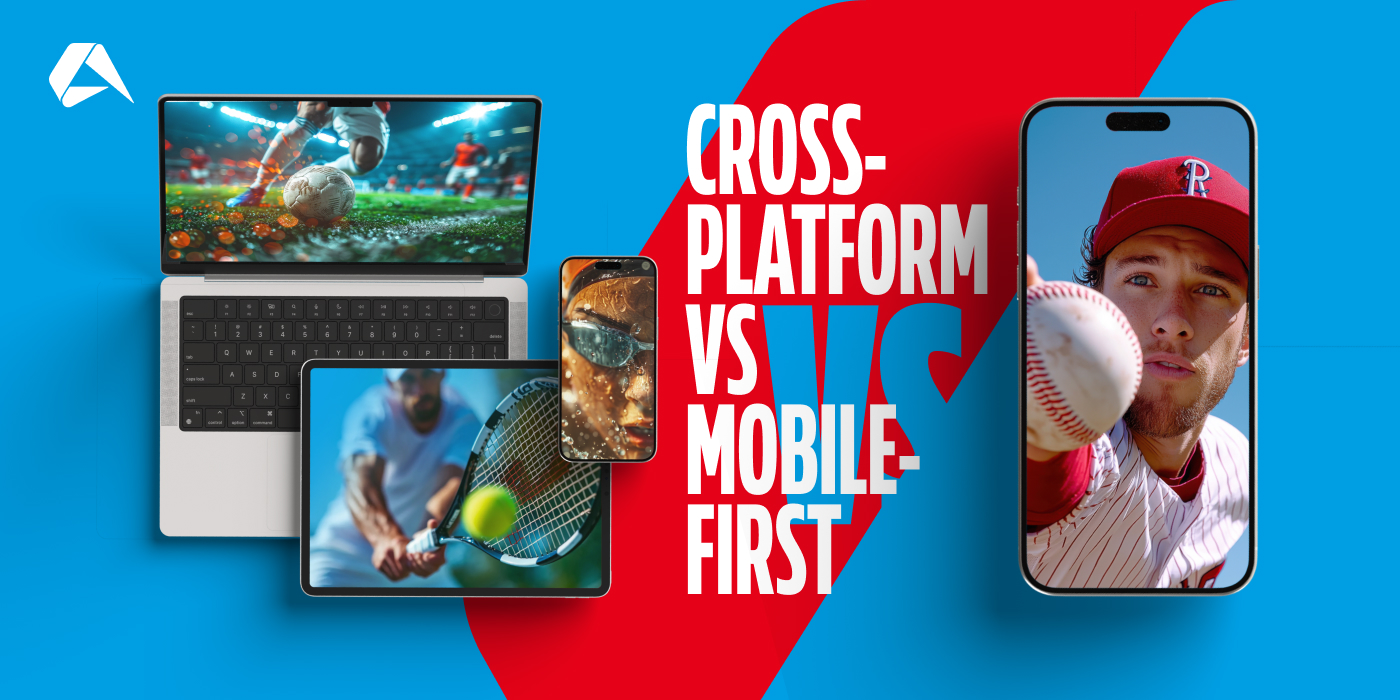
The terms "mobile-first" and "cross-platform" are often used interchangeably, but, in fact, they reflect two different development strategies and understanding that difference matters when planning long-term infrastructure.
What Is Mobile-First Sports Betting?
A mobile-first approach begins with the assumption that most users will access the sportsbook via smartphones. The design, performance, and user flow are built around the mobile experience from day one, and then scaled up to larger devices. It’s efficient, lightweight, and well-suited to markets where mobile usage dominates.
Pros: Fast load times, streamlined interfaces, optimised for mobile betting behaviour.
Cons: Desktop versions may feel basic or less feature-rich by comparison.
What Is Cross-Platform Sports Betting?
By contrast, cross-platform development focuses on delivering a consistent experience across all device types - mobile, desktop, tablet, and beyond. Instead of prioritising one over the other, it aims for parity, using shared codebases or architecture to unify performance and design. It’s more complex but allows for greater flexibility and reach.
Pros: Consistent functionality across devices, broader user access, and easier to manage updates.
Cons: Requires more sophisticated planning to maintain quality across formats.
Both strategies serve a purpose, but they serve different goals. Cross-platform offers a more durable, long-term foundation for operators looking to scale across channels without sacrificing performance.
The Key Features of a Consistent Cross-Platform Betting Experience
Operators building for a cross-platform betting experience need frameworks that don’t flinch under pressure, don’t lag on legacy devices, and do not fracture the user journey. Below are the essential features defining a truly versatile, high-performing cross-platform betting environment.
-
Responsive User Interface: Adapts cleanly to any screen size without distorting sportsbook layouts or natural flow.
-
Unified Codebase: Single source of truth for web, iOS, and Android updates.
-
Device Performance Optimisation: Works efficiently on flagship phones and low-spec legacy models.
-
Real-Time Data Synchronisation: Keeps odds, bet slips, and live content aligned across all devices.
-
Lightweight Front-End Framework: Minimises load times and memory usage for faster user interaction.
-
Progressive Web App (PWA) Compatibility: Delivers app-like experiences directly through a mobile browser.
-
Modular API and SDK Integration: Easily connects with third-party tools and back-office systems.
-
Offline Functionality Support: Allows continued interaction even during momentary connectivity drops.
-
Smart Session Management: Maintains user state when switching between devices or screen types.
-
Adaptive Video Streaming: Scales resolution and bitrate based on device and connection quality.
-
Voice-Activated Command Layer: Enables bet placement and navigation through voice inputs.
-
In-App Push and Browser Notifications: Delivers time-sensitive updates across web and mobile channels.
-
Touch and Gesture Input Compatibility: Supports intuitive controls for tablets and modern touch devices.
-
Security and Authentication Parity: Applies consistent identity checks across all access points.
-
Dark Mode and Display Preferences: Carries user visual preferences across devices and sessions.
-
Integrated Responsible Gaming Tools: Timeouts, limits, and alerts function consistently wherever users log in.
Core Technologies That Support Betting Across All Devices
Building a sportsbook that feels consistent across devices doesn’t happen by chance. That’s to say, what feels instant and intuitive to the user is often the result of deeply integrated systems working silently in the background. For industry operators, understanding these core technologies means knowing what’s possible, what can scale without breaking, and what will still make sense three years from now. Below are three foundational technologies that make cross-platform betting functional and commercially viable.
Progressive Web Apps (PWAs)
Progressive Web Apps offer a practical middle ground between mobile websites and native applications, giving players fast, app-like performance without requiring a trip to the App Store. For operators, that brings real benefits. Thanks to built-in offline support, PWAs load quickly, adapt to different screen sizes, and work reliably even in poor connection areas. Push notifications keep bettors in the loop during live events, and the update process is simple with no app versioning headaches or rollout delays.
PWAs are especially valuable in markets where users may not download native apps or where app store restrictions create compliance constraints. In short, they provide operators with greater agility and reach, all while maintaining the predictable betting experience that today’s bettors expect.
Flexible SDKs and APIs
No sportsbook exists in a vacuum. Platforms must plug into multiple systems to deliver a truly cross-device experience, from payment providers and KYC checks to live odds feeds and streaming services. That’s where flexible SDKs (Software Development Kits) and APIs (Application Programming Interfaces) come in. They act as the glue that connects services, allowing operators to customise functionality while keeping the underlying architecture stable.
A good API framework supports real-time data exchange, enabling instant bet placement, synchronised odds, and dynamic content updates across every device. With modular SDKs, features can be rolled out or refined without disrupting the core product. These tools are foundational for cross-platform betting to work at scale.
Cloud-Based Infrastructure
Scalability used to be a growth problem. Now it’s a daily requirement. Cloud-based infrastructure gives sportsbooks the flexibility to serve thousands and even millions of users across devices without performance dips. It reduces latency, which matters considerably when live odds are shifting by the second, and it allows operators to distribute content closer to the user, wherever they are.
From an operational perspective, cloud systems make maintenance easier and deployment faster. Updates can be pushed without downtime, and scaling up no longer means rebuilding from scratch. This infrastructure also plays a key role in supporting session continuity, so players switching from phone to desktop mid-bet don’t lose their progress. And that’s the real value - consistency, delivered invisibly.
Emerging Trends in Cross-Platform Sports Betting
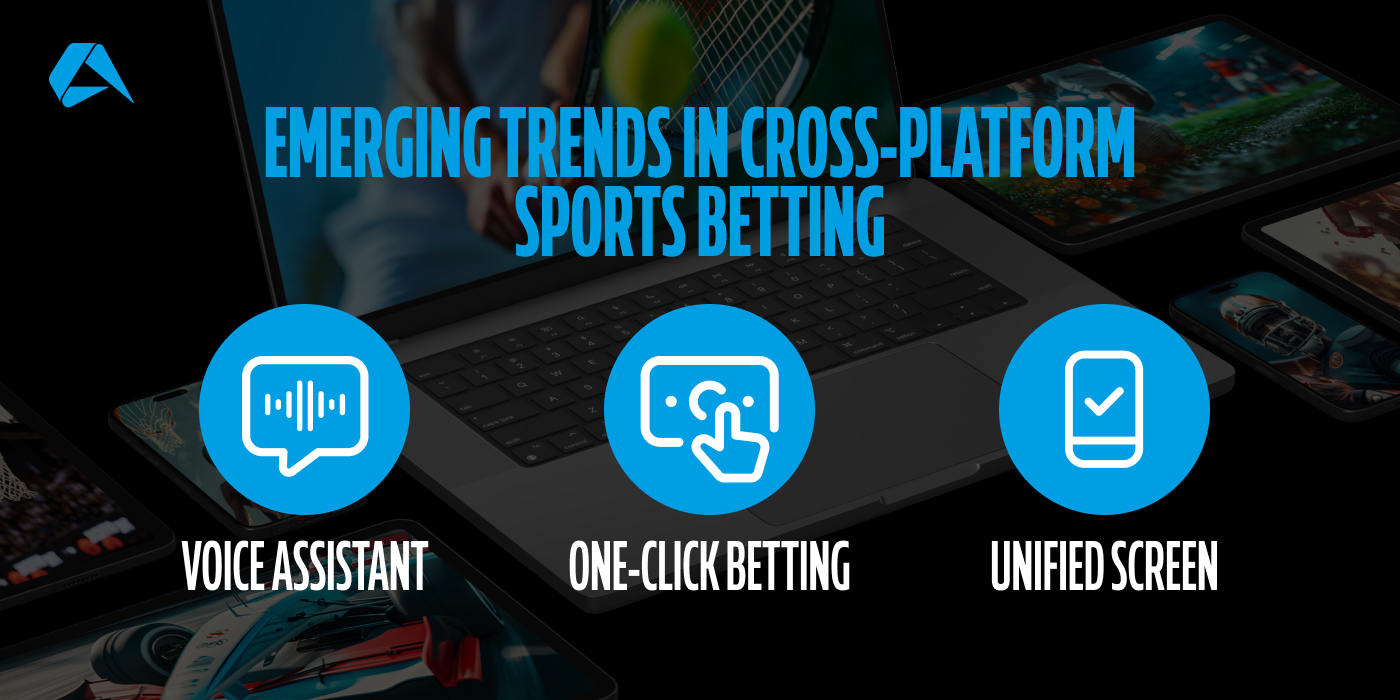
Now that cross-device stability is a given with stable core technologies in place, the focus shifts to the user experience and the deeper question of what more we can do and what actually keeps players coming back. In today’s market, that means building smarter, faster, more intuitive betting experiences that feel like a natural extension of how people already engage with sports betting.
One trend gathering pace is voice-activated betting. As smart speakers and voice assistants make their way into living rooms, cars, and even wearables, the idea of placing a bet without lifting a finger is quickly moving from novelty to expectation. It’s the next logical step, especially for in-play markets, but it brings new challenges. Operators must think carefully about how voice commands are authenticated, how misfires are prevented, and how regulatory controls hold up when no screen is involved.
One-click betting is another area attracting much attention, which is especially useful during live matches where speed and timing are everything. Simplifying the journey from impulse to bet slip can significantly lift engagement, but it’s a delicate balance. Speed shouldn’t come at the cost of clarity. Thoughtful confirmation flows, betting limits, and configurable safeguards are now part of that conversation.
Yet, even speed has its limits if the experience is fragmented, and this is why the days of flicking between a stream and your bet slip are numbered. Players now expect everything on one screen - the match, the markets, and the data that informs their decisions.
Operators who combine this into a single, responsive interface that adapts effortlessly to whatever screen the player is using will set new standards in personalisation and retention.
Cross-Platform Solutions for Emerging Markets
In practice, there’s a tendency in platform development to optimise for best-case scenarios with users operating high-end phones, 5G connections, and modern operating systems. But that’s not where the next wave of growth is coming from. In emerging sports betting regions, where connectivity can be patchy at best and low-spec Android devices dominate, sportsbooks that perform well under pressure have the chance to secure a clear commercial advantage.
The opportunity here is often underestimated. By stripping down data-heavy elements, compressing assets, and limiting third-party dependencies, operators can significantly reduce load times and memory strain without cutting corners on functionality. Every second shaved off load time adds up when latency is the bottleneck, not the user.
Maintaining UX on legacy devices also requires intelligent choices. Prioritising text over image-heavy content, pre-loading bet slips efficiently, and making support available offline, for instance, should be factored into early decisions and not an afterthought. It’s less about doing less and more about doing only what matters.
Betting doesn’t stop because the network drops. Platforms that recognise this and build accordingly will reach more players and retain them in markets where loyalty is often earned through reliability, not flashy apps and visual clutter.
Altenar's Approach to Cross-Platform Betting
Operators looking to future-proof their sportsbook often start with the same three questions: How do we build it intelligently, affordably, and at scale? Who can get us there quickly? And what actually matters to players in 2025, versus what’s just noise?
Altenar brings a clear, practical answer to each of these concerns. Rather than retrofitting platforms to meet cross-platform demands, Altenar builds for compatibility from the outset. Its mobile-first, device-flexible infrastructure, powered in part by Flutter, allows operators to deploy consistent, high-performance betting experiences across smartphones, tablets, desktops, and webviews without maintaining multiple codebases.
Infrastructure That Adapts as Fast as Players Do
But the advantage runs deeper. Altenar’s modular framework makes it easy to integrate with third-party systems, deliver real-time updates across devices, and adapt UI behaviour to meet the context of the screen in use. The result? Faster time to market, fewer technical constraints, and a user experience that moves with the player, not against them.
And it’s here that Altenar’s cross-platform credentials become impossible to ignore. The platform offers adaptive interfaces that intelligently respond to the nuances and constraints of each device, whether it’s a small-screen Android or a widescreen desktop. Under the hood, a high-performance architecture ensures real-time odds, market updates, and user actions remain synchronised across sessions, with no lag or disconnect.
For operators, this reliability is backed by comprehensive SDKs and APIs that simplify integration with third-party services, custom modules, and external data feeds. Whether building a bespoke front end or embedding sportsbook features into a broader platform, developers gain the freedom to scale and evolve without rebuilding from scratch. It’s a modern, developer-aware approach to sportsbook infrastructure that reflects the way operators work today.
From Codebase to Conversion
Altenar’s attention to technical flexibility doesn’t just benefit development teams. It drives measurable gains across the board. For operators, fewer codebases mean fewer moving parts, quicker deployments, and lower maintenance overhead. That operational simplicity frees up resources to focus on product, not patchwork.
On the user side, the payoff is consistency. Players don’t need to relearn the interface when switching devices. Real-time updates keep them locked into the moment without interruption. This continuity leads to higher engagement, longer session times, and a measurable lift in user satisfaction.
Altenar has seen strong adoption across regulated and growth markets, with operators citing ease of rollout and performance stability as standout features. Ultimately, the platform’s cross-device cohesion checks more than a technical box. It supports a cleaner, smarter business model that rewards both user loyalty and internal efficiency.
Curious how Altenar’s cross-platform engine performs under real-world conditions? Schedule a live walkthrough today and experience the difference a true cross-platform solution can make.
